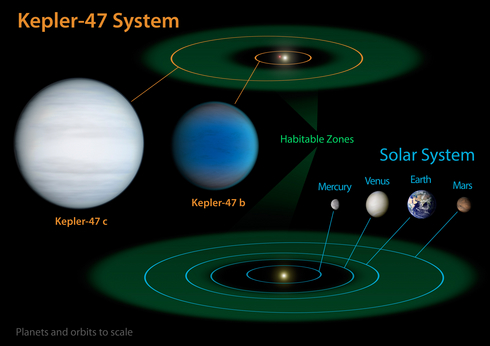Image: NASA

NASA’s Kepler probe has discovered a solar system orbiting twin suns. Thrilled scientists announced the discovery of the Kepler 47 system a few hours ago, via a reference to Star Wars (naturally). “It’s Tatooine, right?” said astronomer Michael Endl of the University of Texas’ McDonald Observatory, which is working with the Kepler data.
NASA’s Kepler probe flies around the galaxy looking for places with the conditions for life. A NASA description of the mission (read it here, it’s fun) explains that the probe “is specifically designed to survey our region of the Milky Way galaxy to discover hundreds of Earth-size and smaller planets.” The goal is to find a few planets in a “habitable zone,” where conditions for water might be present.
Professionalism dictates we explain the Hollywood reference, which perhaps six or ten readers might not have caught. In the famous space opera, Tatooine is the desert home of hero Luke Skywalker, a sullen teenager who forlornly watches his boring planet’s dual suns setting and wonders if that’s all there is to life, before fate taps him to leave home and save the galaxy. The sunset in the Kepler system, where two stars orbit each other, would look pretty much like it does in the movie, apparently. This is the first discovery of a planetary system with multiple planets orbiting multiple stars. A NASA graph of the new planets is above and a NASA description of the system is here. The planets are “ice giants,” meaning it’s not likely anyone lives there. (A hopeful question: couldn’t ice giants live there?)
Though Kepler’s mission sounds like more of a Star Trek, “to explore strange new worlds” vibe, we respect astronomer Endl’s right to make his own nerd choices. It’s pretty thrilling that tax money is still paying for this sort of thing.



